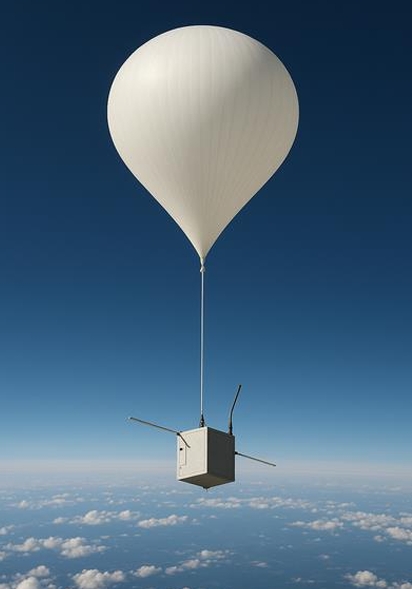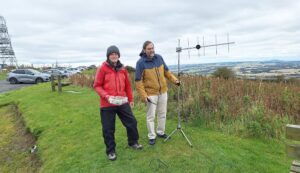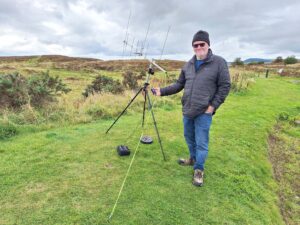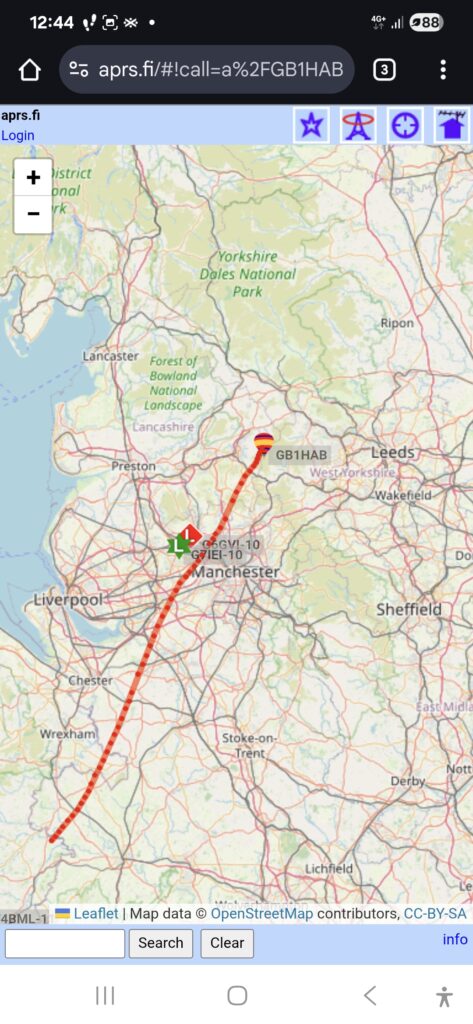
The LoRa Balloon.

Colin GM4EAU & Iain GM8LYQ on East Lomond in Fife.

Local (Fife) amateur Dougie MMØISH was also there.
(See also his interesting page on www.QRZ.com)

GB1HAB-LoRa-Balloon-track
20 Sept 2025 – RSGB LoRa Balloon Challenge – entered by LRS members Colin GM4EAU, Iain GM8LYQ from East Lomond car park & Alan GM8LKL in Currie. Balloon was released from North Wales. See RSGB RadCom Sept 2025, p.53 & rsgb.org/lora-balloon (Click).
REPORT BY COLIN GM4EAU & Iain GM8LYQ:
The RSGB aim of the LoRa balloon challenge was to have fun, learn something new and to be part of a challenge that brought radio amateurs of all ages together in a special event. We decided to enter the challenge to understand LoRa based APRS (Automatic Packet Reporting System) location tracking theory and how it operates in practice. On the day, the balloon barely reached half the planned 90,000ft altitude (that’s 17 miles high!) and our tracker signal was not recorded on the ground. However, we learned about LoRa trackers, balloons, and much more. LoRa APRS tracker transmitters intermittently send their identity and GPS position at milliwatt power levels, so are lightweight and can have long operating endurance from a small battery. LoRa uses forward error correction and spread-spectrum techniques to decode received signals which can be -7.5dB to -20dB below the noise floor. The competition task was to transmit a LoRa APRS tracker signal on 439.85 MHz using a small portable station to a high-altitude balloon carrying a digital repeater. The balloon would “digipeat” received LoRa data packets on a different downlink frequency to “iGates” and from there onto the internet. Five iGates were set up for the challenge on mountain tops, four of them manned, intended to provide coverage for the full balloon flight. Using a conventional internet web browser, we could then observe if our signal was received by the balloon and under what conditions. The competition element was to be the tracker station at the farthest distance from the balloon launch site received by the balloon. Critically, the competition gave us a hard deadline to put a system together and between three of us we just managed to get organised in time for the balloon launch.
The maximum height reached by a weather-type balloon is primarily determined by how much gas is used to partially inflate the balloon at the launch site. As the balloon rises, atmospheric pressure drops and the balloon expands. Eventually the balloon fabric stretches to bursting point and the payload descends to the ground on a parachute. The LoRa challenge balloon was to be initially inflated to a diameter of about 7ft with about 5 cubic metres of helium. At 90,000ft the balloon diameter was expected to reach 27ft at which point it would burst.
After considerable debate within the club we had calculated that the balloon would need to be above 40,000ft for a clear path from the Edinburgh area, depending on transmitter altitude and local obstructions. The free-space path loss at 439MHz over the anticipated 350km distance was around -124dB, giving us about 4dB above noise for 100mW into a dipole. The competition specified a maximum EIRP of 200mW, but confusingly the RSGB briefing notes suggested a high gain antenna be used to improve the chance of winning! Several different designs of commercially-made antenna were available and considered for use, but in the end a home-brew approach was adopted. For portability in the originally anticipated hill climbing Iain GM8LYQ, using only scrap materials (apart from a bit of glue and solder), built a 5 element Yagi to a design by DK7ZB (thank-you Brian GM4DIJ for the pointer). Configuring the software and loading this into the recommended single board Heltec computer was relatively straightforward, after a number of false starts and much testing. Non-recommended boards were attempted initially but this proved problematic in the time available. Alan GM8LKL set up a test iGate in Edinburgh to listen to tests of our signal on 139MHz and this allowed us to check that software and Heltec board configurations were correct. In the competition there was no opportunity to make any in-flight changes.
Our initial plan was to operate from the top of Scald Law at 1,900ft, giving a clear horizon toward the balloon launch site in Wales. However, with bad weather forecast, Colin GM4EAU and Iain GM8LYQ took a car to East Lomond hill in Fife and operated from the car park at 1,100ft. Alan GM8LKL worked from his garden in Currie, Edinburgh, from where at the 90,000ft maximum expected altitude the balloon should be well above the local horizon.
On the morning of the launch, weather radar showed a band of heavy rain across north Wales to the Humber. The launch site at Welshpool was wet, but the balloon was released at 11:10 BST as planned and it rose steadily at about 700 ft/min, drifting northeast. Arriving at East Lomond car park at 11:05 BST we spotted Dougie MM0ISH who was also trying the challenge and we chatted amicably while setting up. Our transmitter and antenna configurations were very similar, but we placed our Heltec board with its integrated GPS receiver a few feet further from the balloon launch site! Local conditions were dry at East Lomond, but wet in Currie. Setting up the antenna at the edge of the East Lomond parking area revealed a lump of local hillside just off the line of sight, but also some annoyingly high Pentland peaks directly in line with north Wales. Nothing daunted, our tracker was active by around 11:20 BST. An hour later at 12:20 BST and 48,556ft over Manchester the balloon burst, descending at 2,700 ft/min to land at 12:35 BST in a remote location near Thursden in West Yorkshire.
If the balloon had reached the full height we might have had around 30 minutes to get a packet into the balloon’s digipeater. With the actual height achieved by the balloon we probably only had two or three minutes where in theory we stood any chance of communicating with the balloon. GM3STM in Auchinleck, 67 miles SW of East Lomond, heard the balloon down-link on 433.85MHz for about 10 minutes. This suggests that we needed only five minutes more balloon ascent time to have had a reasonable chance of being heard from our site. A further difficulty is that as the balloon rises and more trackers come into range the likelihood that the transmissions of two or more trackers will collide increases.
Overall we collectively agreed the event was a success for us (and the RSGB!) in that we set up and ran a LoRa tracker station and in the process learnt about weather ballooning, simulation of balloon tracking, programming LoRa ESP32 based processor boards, Microsoft Visual Studio, UHF path propagation simulation, link budgets, LoRa technology, and directional antenna construction. The fact that we didn’t achieve a balloon link was not really that important in the final outcome and the journey in preparation was as much (some might say more) fun than the actual competition itself.
The high-altitude balloon launch took place on Saturday 20th September from Welshpool in North Wales. A YouTube recording of the launch with commentary is at: https://www.youtube.com/watch?
73
GM4EAU, GM8LYQ, GM8LKL
